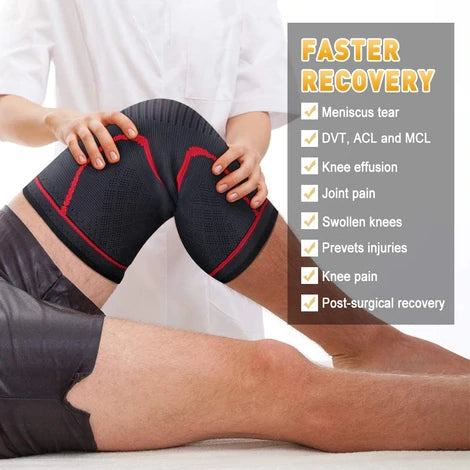
How to choose a knee pad that really suits you?
Share
Knee is a common site of sports injuries. Knee injuries not only affect motor function, but also limit activities of daily living. Whether preventing knee injuries or protecting injured knees, knee pads play a big role in it. So how do we judge whether we need to wear knee pads, and how to choose a suitable knee pad?
Whether we need to wear knee pads depends on whether we have the following needs:
1. Sports protection:
The knee joint itself is not damaged, but the knee joint may be injured during strenuous exercise, so you need to wear knee pads to prevent injury.
2. Damage prevention:
The soft tissues of the knee joint such as ligaments and other injuries need to wear knee pads to avoid the aggravation of the injury and promote the recovery of the injury.
3. force line correction:
The knee joint is deformed due to rheumatism and other diseases. The abnormal alignment of the lower limbs caused by the joint deformation will aggravate the damage to the knee joint. At this time, it is necessary to wear a knee brace to correct the alignment of the lower limbs.
At the same time, some knee pads also have the effect of keeping warm. To put it simply, if your knees are healthy, you can wear knee pads to avoid injury when participating in some strenuous sports; if your knees have been injured, wearing a knee pad can avoid the further development of the injury and ensure sports. Done successfully.
Related Articles: How to Choose Knee Pads Scientifically
How to choose a suitable knee pad?
01.Patella wrapping type
1) Tubular knee pads: This type of knee pads can completely cover the knee joint and play a certain role in fixing and supporting the entire knee joint. At the same time, it can control the slight swelling of the knee. Warm joints.
Applicable people: Suitable for people with mild knee problems and difficulty in distinguishing the position of knee pain, or people who have the habit of jogging and brisk walking.
Note: It is not suitable for daily wear, because the patella is completely covered. When the knee joint is bent more than 45 degrees, the knee pad will limit the relative position of the patella and the femur, which will increase the probability of patella degeneration and aggravate knee pain in the long run. Therefore, it is not suitable for people who often need to go up and down stairs or squat.
2) For people who have meniscus damage and like to walk, they can choose supportive knee pads, which can share a part of the load on the meniscus to protect the meniscus.
3) For those who have ligament injury and still need to participate in sports, they can choose a fastened support knee pad. The tightness of the knee pads can limit the range of motion of the knee joint, and with the support bars on the side, it can effectively relieve the pressure on the ligaments and prevent re-injury.
02.Patellar pressure relief type
This knee brace is designed with an opening at the position of the patella, and the opening is specially thickened and strengthened. The design of the opening reduces the pressure of the knee brace on the patella to a certain extent, and can better fix the patella to avoid friction and pain caused by abnormal movement of the patella.
Applicable people: Suitable for people who have abnormal movement of the patella, pain behind the patella, difficulty in going up and down stairs and squatting, and often running. This type of knee brace can be worn in everyday life because it does not compress the patella and limit the flexion of the knee joint.
03. Belt type
Also known as the patellar compression band or the patellar band, it is a circular ring and is fixed to the patellar tendon below the patella. Band-type knee braces give the patellar tendon a certain binding force, which can reduce the excessive traction of the patellar tendon during exercise, thereby reducing pain and allowing the patellar tendon to get a proper rest, but this type of brace has no protective effect on other parts of the knee joint. These knee braces are not suitable for people with ligament and meniscus injuries.
Applicable people: It is suitable for patients with patellar tendinitis and pain under the knee. It is also suitable for people who often run, jump, like ball games or ride often.
There are many types of knee pads, and only the right one can protect the knees. Of course, in addition to the above types, the choice of knee pads should also consider the material and size. In addition, in the choice of knee pads, we must combine our own actual conditions, and we should not pursue functionality excessively, because the stronger the functional knee pads, the better the protection and support effect, and the greater the scope of the impact on the exercise effect. Great discount.
The two sides of knee pads cannot be ignored:
The knee pad undertakes the task of a part of the muscles around the knee, and the auxiliary muscles play a role in supporting and maintaining the stability of the knee, thereby protecting the knee. Because of this, the long-term use of knee pads will cause the muscles to not get enough exercise and become weaker and weaker. Once the knee pads are not worn, the knees are more likely to be injured.
Therefore, for people with healthy knees, general sports such as short-distance jogging, walking, cycling, etc. do not need to wear knee pads. For people with knee injuries, knee pads can be properly worn, but at the same time, attention should be paid to the exercise of the muscles around the knee.
Articles you may be interested in: Are knee braces good for arthritis?











